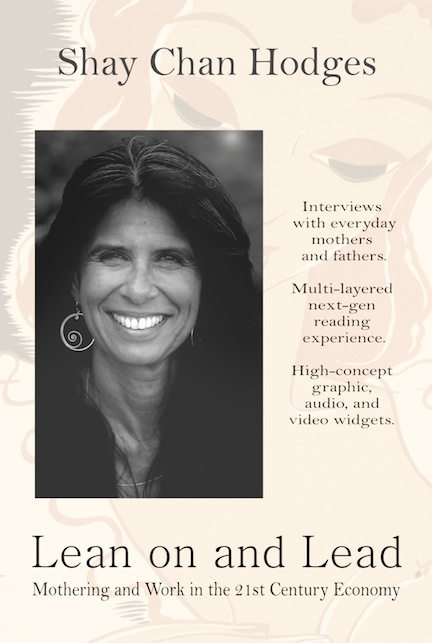 WHO SHE IS: Shay Chan Hodges, Author, Interactive iBook, Lean On and Lead, Mothering and Work in the 21st Century Economy
WHO SHE IS: Shay Chan Hodges, Author, Interactive iBook, Lean On and Lead, Mothering and Work in the 21st Century Economy
LOCATION: Maui, Hawaii
SUCCESS STORY: Published Lean On and Lead, which resulted in an invitation to the White House Summit on Working Families
WORK SCHEDULE: 7 a.m. or so until 2:30 p.m.-ish, then intermittently until dinner, with more work after dinner if needed
KIDS: Keane (16) and Liam (17)
SANITY VICE: Start every day with a cappuccino; get into groove slowly while drinking coffee. Walk on the beach (with a bit of swimming) a few times a week.
RECENT SMART READ: Overwhelmed by Brigid Schulte
BEST TIME-MANAGEMENT TIP: Teenagers take care of as much as possible themselves/contribute to family (clean, do errands, etc.) – they’re almost adults after all!
GO-TO TECH: Even though I wrote an interactive iBook utilizing the next-gen Apple iBooks Author platform, I’m not that much of a techie! My Mac is 8 years old (but it’s upgraded to Mavericks!)
BETTER WAY TO SAY WORK-LIFE BALANCE? Between the social pressure of high parenting expectations and economic realities that require two parents to often work more than 40 hrs each per week, “balancing” work and life is an impossible goal. What if, instead, our work structures provided the time and flexibility needed for rich and nurturing lives, and our community/family life supported engaged work that could financially sustain us? How about “Work-Life Sustainability”?
Q&A with Shay
1. Tell us about Lean On and Lead and your mission.
In 2013, I began interviewing working parents about their child care challenges as part of a freelance assignment. These professionals — a lawyer, a media VP, a venture capitalist, medical professionals, teachers — told extremely compelling and detailed stories about their lives and their efforts to accommodate the imbalance of work and parenting. As the mother of two teenage sons, I could relate to their decisions, and having owned a children’s book store for six years, I was reminded of countless conversations I’d had with parents about the challenges of raising a family. It was also very important to these parents, primarily mothers, that their stories be told. In spite of intense work and family demands, not only were they willing to contribute their time to the project, they were eager to hear each other’s stories. After the contract ended, I decided to interview more diverse parents, realizing that the “state of the family” cannot be separated from the “state of the economy.” And that while each family’s situation is unique, there are many common structural issues that if addressed, could make day-to-day living easier. I chose to publish via Apple iBooks Author so I could present these personal stories with current and comprehensive data and research in a graphically pleasing and easy-to-access format.
2. You were at the White House Summit on Working Families. Do you think it will move the needle in any way?
I believe the Summit contributed to moving the needle by raising visibility and credibility for the issues facing women and working families, and also by motivating working parents and activists to keep the conversation going and work on concrete initiatives.
One of the most empowering aspects of the Summit was the fact that a range of professionals – from President Obama and members of his cabinet to organizational and business leaders – introduced themselves first as parents, telling their own personal family stories, and then spoke about their roles in this movement. As parents, we often feel like we have to hide the fact that we have children or are caretakers in order to ensure that we appear professional. Yet most people are impacted by family on a daily basis (which is positive!) – and we should not have to pretend otherwise in order to have our work respected.
3. What are three promising policies you see taking shape or in place that will most benefit working moms/families?
Though the Summit was inspiring, due to our divided Congress, I believe it will be difficult to change national policies much in the near-term. That doesn’t mean we shouldn’t invest time and effort into ensuring these issues are addressed in national conversations, and to work towards passing federal laws requiring paid leave, flexible workplaces, and fair pay, for example. However, to implement concrete change in the short run, I believe we need to make changes on community and state levels, and look for additional creative solutions beyond government.
Thus, the avenues for transforming public policy that I believe are most likely to be effective in the near future, and which take into consideration the unique needs and characteristics of the diversity of our families and communities are:
- Passing Legislation Locally: I believe we need to work to change legislation on city/county and state levels, and whether these laws relate to paid family leave, zoning that accommodates intergenerational support, or creative tax benefits for on-site day care or flexible workplaces, for example, will depend on the political and demographic make-up and needs of specific regions.
- Electing Working Mothers in Every Level of Government: For significant change that improves the daily lives of families, I believe we need more working mothers in office, regardless of political affiliation, who have an understanding of what the day-to-day needs of families are, and are both invested in fighting for families and in developing a wide range of creative options.
- Implementing and Enforcing Existing Laws Like Title IX: Though it is primarily known for its role in women’s access to sports programs, the Patsy Mink Equal Opportunity in Education Act that passed 42 years ago guarantees equal access to education, regardless of gender. Thus, it is responsible for women surpassing men in college enrollment and degree attainment, and is currently being utilized to address sexual harassment on college campuses. Many people, including female college students and employees, are not aware that Title IX also provides family-related protections for those who work for and attend colleges. Further, Title IX can be utilized to ensure equal access to STEM programs, not only in primary education, but also at a university level. It can also be used to enforce equal pay for college faculty and staff. We need to ensure that great laws that are already in place are being enforced and implemented.
4. What would be your most ideal policy to implement if you needed to.
To elect more working mothers because once we have children, nothing is theoretical.
Follow Shay @LeanOnAndLead





